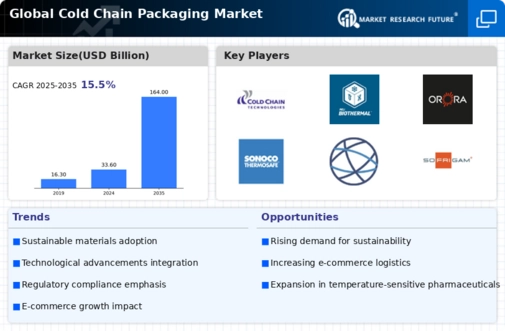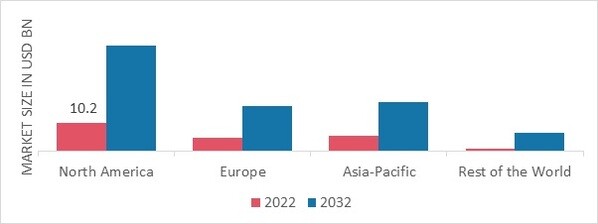-
EXECUTIVE SUMMARY
-
MARKET INTRODUCTION
-
Definition
-
Scope of the Study
-
Research Objective
-
Assumptions
- Limitations
-
RESEARCH METHODOLOGY
-
Overview
-
Data Mining
-
Secondary Research
-
Primary Research
- Primary
-
Interviews and Information Gathering Process
-
Breakdown of Primary
-
Respondents
-
Forecasting Model
-
Market Size
-
Estimation
-
Bottom-Up Approach
- Top-Down
-
Approach
-
Data Triangulation
-
Validation
-
MARKET DYNAMICS
-
Overview
-
Drivers
-
Restraints
-
Opportunities
-
MARKET FACTOR ANALYSIS
-
Value Chain Analysis
-
Porter’s Five Forces Analysis
-
Bargaining Power of Suppliers
-
Bargaining Power of Buyers
-
Threat of New Entrants
-
Threat of Substitutes
-
Intensity of Rivalry
-
COVID-19 Impact Analysis
-
Market Impact Analysis
-
Regional Impact
-
Opportunity and Threat Analysis
-
GLOBAL COLD CHAIN PACKAGING MARKET,
-
BY PRODUCT TYPE
-
Overview
-
EPS Containers
-
PUR Containers
-
Pallet Shippers
-
Vacuum Insulated
-
Panels
-
Others
-
GLOBAL COLD CHAIN PACKAGING MARKET,
-
BY APPLICATION
-
Overview
-
Pharmaceuticals
-
Food
-
Industrial
-
GLOBAL COLD CHAIN PACKAGING
-
MARKET, BY REGION
-
Overview
-
North America
-
U.S.
-
Canada
-
Europe
-
Germany
-
France
- U.K
-
Italy
-
Spain
- Rest of Europe
-
Asia-Pacific
-
China
- India
-
Japan
-
South Korea
- Australia
-
Rest of Asia-Pacific
-
Rest of the World
- Middle
-
East
-
Africa
- Latin America
-
COMPETITIVE LANDSCAPE
-
Overview
-
Competitive
-
Analysis
-
Market Share Analysis
-
Major Growth
-
Strategy in the Global Cold Chain Packaging Market,
-
Competitive
-
Benchmarking
-
Leading Players in Terms of Number of Developments
-
in the Global Cold Chain Packaging Market,
-
Key developments and
-
Growth Strategies
-
New PRODUCT TYPE Launch/Application Deployment
-
Merger & Acquisitions
-
Joint Ventures
-
Major Players Financial Matrix
-
Sales & Operating Income,
- Major Players R&D Expenditure. 2022
-
COMPANY PROFILES
-
Cold Chain Technologies
-
Company Overview
-
Financial Overview
-
Product Offered
-
Key Developments
- SWOT
-
Analysis
-
Key Strategies
-
Peli BioThermal
-
Company Overview
-
Financial Overview
-
Product Offered
-
Key Developments
- SWOT
-
Analysis
-
Key Strategies
-
Orora Group
-
Company Overview
-
Financial Overview
-
Product Offered
-
Key Developments
- SWOT
-
Analysis
-
Key Strategies
-
Sonoco ThermoSafe
-
Company Overview
-
Financial Overview
-
Product Offered
-
Key Developments
- SWOT
-
Analysis
-
Key Strategies
-
CREOPACK
-
Company Overview
-
Financial Overview
-
Product Offered
-
Key Developments
- SWOT
-
Analysis
-
Key Strategies
-
Sofrigam
-
Company Overview
-
Financial Overview
-
Product Offered
-
Key Developments
- SWOT
-
Analysis
-
Key Strategies
-
INTELSIUS
-
Company Overview
-
Financial Overview
-
Product Offered
-
Key Developments
- SWOT
-
Analysis
-
Key Strategies
-
Nordic Cold Chain
-
Solutions
-
Company Overview
- Financial
-
Overview
-
Product Offered
- Key Developments
-
SWOT Analysis
-
Key Strategies
-
Tempack
-
Company Overview
-
Financial Overview
-
Product Offered
-
Key Developments
- SWOT
-
Analysis
-
Key Strategies
-
Cryopak
-
Company Overview
-
Financial Overview
-
Product Offered
-
Key Developments
- SWOT
-
Analysis
-
Key Strategies
-
Softbox Systems
-
Company Overview
-
Financial Overview
-
Product Offered
-
Key Developments
- SWOT
-
Analysis
-
Key Strategies
-
Sealed Air Corporation
-
Company Overview
-
Financial Overview
-
Product Offered
-
Key Developments
- SWOT
-
Analysis
-
Key Strategies
-
APPENDIX
-
References
-
Related Reports
-
LIST
-
OF TABLES
-
FORECAST, 2025 - 2034 (USD BILLION)
-
MARKET, BY PRODUCT TYPE, 2025 - 2034 (USD BILLION)
-
COLD CHAIN PACKAGING MARKET, BY APPLICATION, 2025 - 2034 (USD BILLION)
-
NORTH AMERICA COLD CHAIN PACKAGING MARKET, BY PRODUCT TYPE, 2025 - 2034 (USD BILLION)
-
NORTH AMERICA COLD CHAIN PACKAGING MARKET, BY APPLICATION, 2025 - 2034 (USD BILLION)
-
NORTH AMERICA COLD CHAIN PACKAGING MARKET, BY COUNTRY, 2025 - 2034 (USD BILLION)
-
U.S. COLD CHAIN PACKAGING MARKET, BY PRODUCT TYPE, 2025 - 2034 (USD BILLION)
-
U.S. COLD CHAIN PACKAGING MARKET, BY APPLICATION, 2025 - 2034 (USD BILLION)
-
CANADA COLD CHAIN PACKAGING MARKET, BY PRODUCT TYPE, 2025 - 2034 (USD BILLION)
-
CANADA COLD CHAIN PACKAGING MARKET, BY APPLICATION, 2025 - 2034 (USD BILLION)
-
EUROPE COLD CHAIN PACKAGING MARKET, BY PRODUCT TYPE, 2025 - 2034 (USD BILLION)
-
EUROPE COLD CHAIN PACKAGING MARKET, BY APPLICATION, 2025 - 2034 (USD BILLION)
-
EUROPE COLD CHAIN PACKAGING MARKET, BY COUNTRY, 2025 - 2034 (USD BILLION)
-
GERMANY COLD CHAIN PACKAGING MARKET, BY PRODUCT TYPE, 2025 - 2034 (USD BILLION)
-
GERMANY COLD CHAIN PACKAGING MARKET, BY APPLICATION, 2025 - 2034 (USD BILLION)
-
FRANCE COLD CHAIN PACKAGING MARKET, BY PRODUCT TYPE, 2025 - 2034 (USD BILLION)
-
FRANCE COLD CHAIN PACKAGING MARKET, BY APPLICATION, 2025 - 2034 (USD BILLION)
-
ITALY COLD CHAIN PACKAGING MARKET, BY PRODUCT TYPE, 2025 - 2034 (USD BILLION)
-
ITALY COLD CHAIN PACKAGING MARKET, BY APPLICATION, 2025 - 2034 (USD BILLION)
-
SPAIN COLD CHAIN PACKAGING MARKET, BY PRODUCT TYPE, 2025 - 2034 (USD BILLION)
-
SPAIN COLD CHAIN PACKAGING MARKET, BY APPLICATION, 2025 - 2034 (USD BILLION)
-
U.K COLD CHAIN PACKAGING MARKET, BY PRODUCT TYPE, 2025 - 2034 (USD BILLION)
-
U.K COLD CHAIN PACKAGING MARKET, BY APPLICATION, 2025 - 2034 (USD BILLION)
-
REST OF EUROPE COLD CHAIN PACKAGING MARKET, BY PRODUCT TYPE, 2025 - 2034 (USD
-
BILLION)
-
2034 (USD BILLION)
-
MARKET, BY PRODUCT TYPE, 2025 - 2034 (USD BILLION)
-
COLD CHAIN PACKAGING MARKET, BY APPLICATION, 2025 - 2034 (USD BILLION)
-
ASIA PACIFIC COLD CHAIN PACKAGING MARKET, BY COUNTRY, 2025 - 2034 (USD BILLION)
-
JAPAN COLD CHAIN PACKAGING MARKET, BY PRODUCT TYPE, 2025 - 2034 (USD BILLION)
-
JAPAN COLD CHAIN PACKAGING MARKET, BY APPLICATION, 2025 - 2034 (USD BILLION)
-
CHINA COLD CHAIN PACKAGING MARKET, BY PRODUCT TYPE, 2025 - 2034 (USD BILLION)
-
CHINA COLD CHAIN PACKAGING MARKET, BY APPLICATION, 2025 - 2034 (USD BILLION)
-
INDIA COLD CHAIN PACKAGING MARKET, BY PRODUCT TYPE, 2025 - 2034 (USD BILLION)
-
INDIA COLD CHAIN PACKAGING MARKET, BY APPLICATION, 2025 - 2034 (USD BILLION)
-
AUSTRALIA COLD CHAIN PACKAGING MARKET, BY PRODUCT TYPE, 2025 - 2034 (USD BILLION)
-
AUSTRALIA COLD CHAIN PACKAGING MARKET, BY APPLICATION, 2025 - 2034 (USD BILLION)
-
SOUTH KOREA COLD CHAIN PACKAGING MARKET, BY PRODUCT TYPE, 2025 - 2034 (USD BILLION)
-
SOUTH KOREA COLD CHAIN PACKAGING MARKET, BY APPLICATION, 2025 - 2034 (USD BILLION)
-
REST OF ASIA-PACIFIC COLD CHAIN PACKAGING MARKET, BY PRODUCT TYPE, 2025 - 2034
-
(USD BILLION)
-
BY APPLICATION, 2025 - 2034 (USD BILLION)
-
CHAIN PACKAGING MARKET, BY PRODUCT TYPE, 2025 - 2034 (USD BILLION)
-
REST OF WORLD COLD CHAIN PACKAGING MARKET, BY APPLICATION, 2025 - 2034 (USD BILLION)
-
REST OF WORLD COLD CHAIN PACKAGING MARKET, BY COUNTRY, 2025 - 2034 (USD BILLION)
-
MIDDLE EAST COLD CHAIN PACKAGING MARKET, BY PRODUCT TYPE, 2025 - 2034 (USD BILLION)
-
MIDDLE EAST COLD CHAIN PACKAGING MARKET, BY APPLICATION, 2025 - 2034 (USD BILLION)
-
AFRICA COLD CHAIN PACKAGING MARKET, BY PRODUCT TYPE, 2025 - 2034 (USD BILLION)
-
AFRICA COLD CHAIN PACKAGING MARKET, BY APPLICATION, 2025 - 2034 (USD BILLION)
-
LATIN AMERICA COLD CHAIN PACKAGING MARKET, BY PRODUCT TYPE, 2025 - 2034 (USD
-
BILLION)
-
2034 (USD BILLION)
-
RESEARCH PROCESS
-
PACKAGING MARKET
-
PACKAGING MARKET
-
(%), BY PRODUCT TYPE, 2022
-
SHARE (%), BY APPLICATION, 2022
-
MARKET, SHARE (%), BY REGION, 2022
-
PACKAGING MARKET, SHARE (%), BY REGION, 2022
-
CHAIN PACKAGING MARKET, SHARE (%), BY REGION, 2022
-
COLD CHAIN PACKAGING MARKET, SHARE (%), BY REGION, 2022
-
REST OF THE WORLD: COLD CHAIN PACKAGING MARKET, SHARE (%), BY REGION, 2022
-
GLOBAL COLD CHAIN PACKAGING MARKET: COMPANY SHARE ANALYSIS, 2022 (%)
-
COLD CHAIN TECHNOLOGIES: FINANCIAL OVERVIEW SNAPSHOT
-
COLD CHAIN TECHNOLOGIES: SWOT ANALYSIS
-
FINANCIAL OVERVIEW SNAPSHOT
-
ORORA GROUP: FINANCIAL OVERVIEW SNAPSHOT
-
SWOT ANALYSIS
-
SONOCO THERMOSAFE: SWOT ANALYSIS
-
OVERVIEW SNAPSHOT
-
SOFRIGAM: FINANCIAL OVERVIEW SNAPSHOT
-
ANALYSIS
-
INTELSIUS: SWOT ANALYSIS
-
FINANCIAL OVERVIEW SNAPSHOT
-
SWOT ANALYSIS
-
TEMPACK : SWOT ANALYSIS
-
SNAPSHOT
-
SOFTBOX SYSTEMS : FINANCIAL OVERVIEW SNAPSHOT
-
: SWOT ANALYSIS
-
SNAPSHOT













